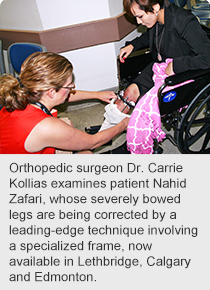
April 25, 2013
Story and Photo by Sherri Gallant
LETHBRIDGE – Nahid Zafari has an item in her wardrobe she can’t wait to wear.
“I want to wear skinny jeans,” she says. “I already have a pair of white ones in my closet, waiting for me.”
Zafari, 24, will get this opportunity later this year thanks to a pioneering orthopedic technique, now available in Lethbridge, that gives new hope to individuals with severe skeletal problems, including bowed legs and limbs of different lengths.
Patients undergo orthopedic surgery to cut through the bone that needs fixing and a circular, metal frame is placed around the limb. This specialized piece of equipment, called the Taylor Spatial Frame, has six telescopic struts that are used to adjust rods, which are screwed into the bone. With daily adjustments to the struts, bones can be lengthened or straightened.
The frame is surgically removed once the correction is complete and the bone is healed, which can take weeks or months.
“This device takes advantage of the body’s natural ability to grow healthy new bone tissue, and the device’s accompanying software system gives surgeons the ability to move bones to their precise anatomic alignment,” says local orthopedic surgeon Dr. Carrie Kollias, who’s specially trained to use the Taylor Spatial Frame system.
Dr. Kollias points out the vast majority of patients with abnormal bone development continue to have their skeletal problems effectively corrected using steel plates screwed onto the bone.
“Plates are widely used because they’re effective, except for a very small number of patients we see every year with severe skeletal problems,” she says.
“Previously, many of these patients would simply find ways to live with their condition on a day-to-day basis. Now, with this procedure and equipment, we can give these patients new hope and hopefully restore their quality of life.”
In Zafari’s case, malnutrition during her childhood spent in Iran led to rickets, a disease that made her knees ache and her growing legs bow outwards, starting at age 12.
“I was too shy to walk through the university, to wear the clothes I want to wear, or to go to parties or to the mall,” says Zafari, a computer sciences student at the University of Lethbridge, who came to Canada four years ago.
“I began to walk sort of like a penguin. And I always had to keep my weight down, as my legs would not support me. I just gave up, but Dr. Kollias gave me a new hope.”
Zafari had one leg fitted with a frame in February, which will be removed in May. Then she’ll undergo the procedure this spring to correct her other leg. By September, both legs are expected to be healed and the second frame removed.
Zafari can walk throughout this process with the frames on – using a walker – and she takes physiotherapy twice a week. Physio will continue in the fall after the second frame is removed.
“This has absolutely changed my life,” says Zafari.
Dr. Kollias says the device offers patients and health care providers many benefits.
“We can correct substantial limb length differences, which cannot be done using a plate and screws,” she says. “Another benefit is patients with leg deformity can undergo this procedure and get back on their feet early into their rehabilitation. When patients can walk on the limb during the healing process, it keeps the muscles functioning in the right range and keeps the joints from getting stiff.”
Three other patients are using, or scheduled to use, the frame in Lethbridge.
“We’re very pleased Dr. Kollias has brought this technique to the South Zone of Alberta Health Services and to Chinook Regional Hospital,” says Dr. Surendar Kilam, Associate Medical Director of the South Zone.
“This kind of innovation provides hope for patients whose skeletal issues have been difficult or even impossible to treat until now.”
In Alberta, the procedure is also available in Calgary and Edmonton.